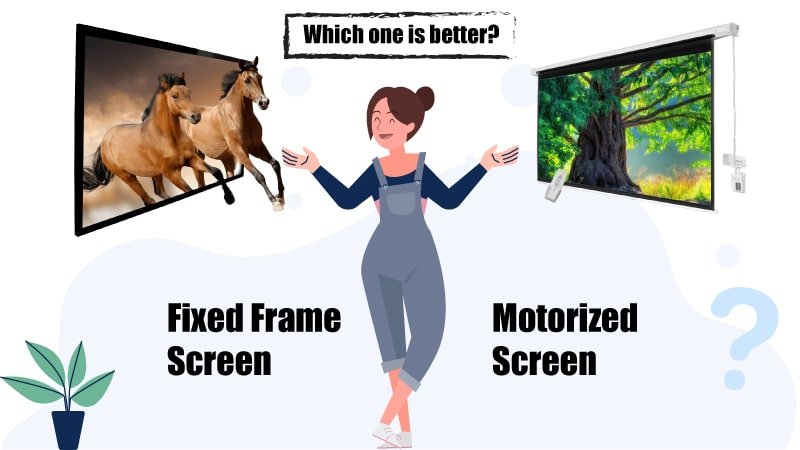Finding the best projector screen out of its many different types is daunting. Therefore, I am bringing you this guide to help you choose the perfect screen type for your purpose. Let’s see which will suit you, a fixed-frame or a motorized screen.

Have you been bored watching your favorite stuff on a Bedsheet, shower curtain, garage door, white project board, big rock, cardboard, or even ceiling? You need a solid replacement to get rid of this temporary stuff: a stand-alone projector screen. But, how to decide between a fixed-frame and a motorized projector screen, and which is the best for you?
Go with a fixed-frame projector screen as far as a home theater is concerned. Since these screens are lightweight and easier to install, they’re better in fixed/dedicated places. On the other hand, a motorized screen is well-suited for a place where you might need to roll it up. Unfortunately, they’re more expensive and require more effort to install. However, they offer more flexibility.
So before we get into their ‘What’s,’ let’s face off some of the key factors making them different from each other.
Design: One of the major differentiators
A Fixed-frame projector screen is fixed with zero moving parts to roll them up and down. On the other hand, a motorized screen has a system—an electric motor—to move it up and down. Moreover, when such a screen is not in use, you can make the occupied area available for other tasks by rolling the screen up using a remote control.
Price: What about the affordability of these screens?
When it comes to pricing, motorized screens are more expensive compared to fixed screens. However, the screen price varies based on many factors, such as brand, size, type, material, and many more.
Installation: Which type requires professional help?
You can install both types independently; however, extra hands are always needed when we install something bigger than us. Comparatively, motorized screens require more installation effort because of their heaviness.
Therefore, some people may require professional help for their installation. Another problem with such a type is its requirement of a high ceiling; you can’t use it in a place with a low ceiling. Otherwise, use any Floor-rising motorized projection screen.
On the contrary, you have fixed screens with lighter weights; you can easily install this type without anyone’s help.
Maintenance: Which type lasts longer?
Motorized screens are hard to maintain since they have electronic parts; these moving parts may put you trouble at times. Therefore, the maintenance of a motorized screen is high.
On the contrary, you have fixed screens with fixed frames; you don’t need to worry about maintenance. Moreover, these screens last longer.
1. Fixed Projector Screens: What are Fixed-frame Projector screens?
Like a picture frame and a blackboard, a fixed-frame projection screen is designed to fit in a fixed position, like on the wall. Such a screen type gives you the flattest projection surface possible.
Suitability: Who’s it for?
A fixed frame projector screen is more popular among people with a dedicated place, such as your home theater, classroom, business meeting room, church, ETC.
What I like: A Fixed frame projection screen.
- Lightweight
- Easy to install
- Cheaper
- Flat and stable
- Acoustically transparent
- Doesn’t require professional installation
Note: Acoustically transparent screens are the screens that allow sound penetration through them. These screens are very useful when speakers are put behind them, allowing sound to pass through them.
Summary: What makes A fixed-frame screen a better choice than a motorized projector screen
Fixed-frame screens are lighter and cheaper. In addition, they give your place a better look because of their flat panel. Some fixed-frame projector screens offer a perforated surface to create a cinematic experience as it blocks light from the other end.
When it comes to installation, you can install them easily because of their straightforward installation.
Motorized Projector Screens: What are motorized projector screens?
A motorized projector screen allows for rolling up and down. This modern world is accepting these screens more because of their portability and neatness.
Unlike fixed-frame projection screens, Motorized screens can save you a large projection surface for other uses as you’re free to roll them up and down as needed. Moreover, such a type has both options to control it: remote control and a manual switch.
Some expensive motorized projection screens also support room automation systems. However, these screens struggle to provide a flat surface like fixed-frame screens.
They can’t remain flat against the heavy wind and other similar outdoor elements. To tackle the issue, manufacturers have brought you two types of motorized screens: Tab-tensioned and Non-tensioned.
1. Tab-tensioned Motorized screens: What is a tab-tensioned motorized projector screen?
As its name suggests, a tab-tensioned screen uses a tension system to keep the screen flat against various outdoor weather elements. In other words, this tension system ensures an unwavering projection surface by keeping tension at every point of the screen.
Moreover, you don’t need to worry about its operation of rolling up and down, as it uses kinetic energy for that. Finally, as a normal motorized/electric screen, you can also control a tab-tensioned electric screen with remote control.
2. Non-tensioned: What is a Non-tensioned Electric/motorized projector screen?
Non-tensioned screens are less stable compared to tab-tensioned screens. Since these screens don’t use any tension system, they struggle to be flat and unwavering.
Suitability: Who’s it for?
A person with a tight space can enjoy both TV and projector on the same wall because motorized screens can retract back up into their casing.
What I like: A motorized projection screen.
- Ability to roll up and down.
- Gives a neat and clean look to your place.
- Supports room automation system.
- Frees up occupied space for other uses.
Related: Best Motorized Projector Screens
FAQs: What do people often ask about projector screens?
What are the other popular projector screens types?
When we go out in the market to look for a projector screen, we see different types of screens staring at us: tripod screens, tab-Tensioned screens, floor Rising screens, double stand screens, electric/motorized screens, manual screens, fixed frame screens, Etc.
Does a tab-tensioned motorized projector screen struggle to roll up and down?
No, it doesn’t. Most tab-tensioned projection screens use kinetic energy to handle their workings. So, without any problem, you can roll them up and down.
Does the quality of a screen matter?
Yes, the quality matters, be it fixed-frame or motorized; it depends on your screen type. Different types of projector screens are available on the market for different purposes. For Example, ALR screens for ambient light, CLR screens for UST projectors to handle the washout effect of ambient light, white screens, gray screens, black screens, Etc.
Conclusion: Which one will you choose? A fixed frame or a motorized projector screen?
So, this has been the topic to know which is better: a Fixed-frame or Motorized Projector Screen. Since these were the two main projector screen categories, we looked at them in detail.
Related: Projector Screen Buying Guide

